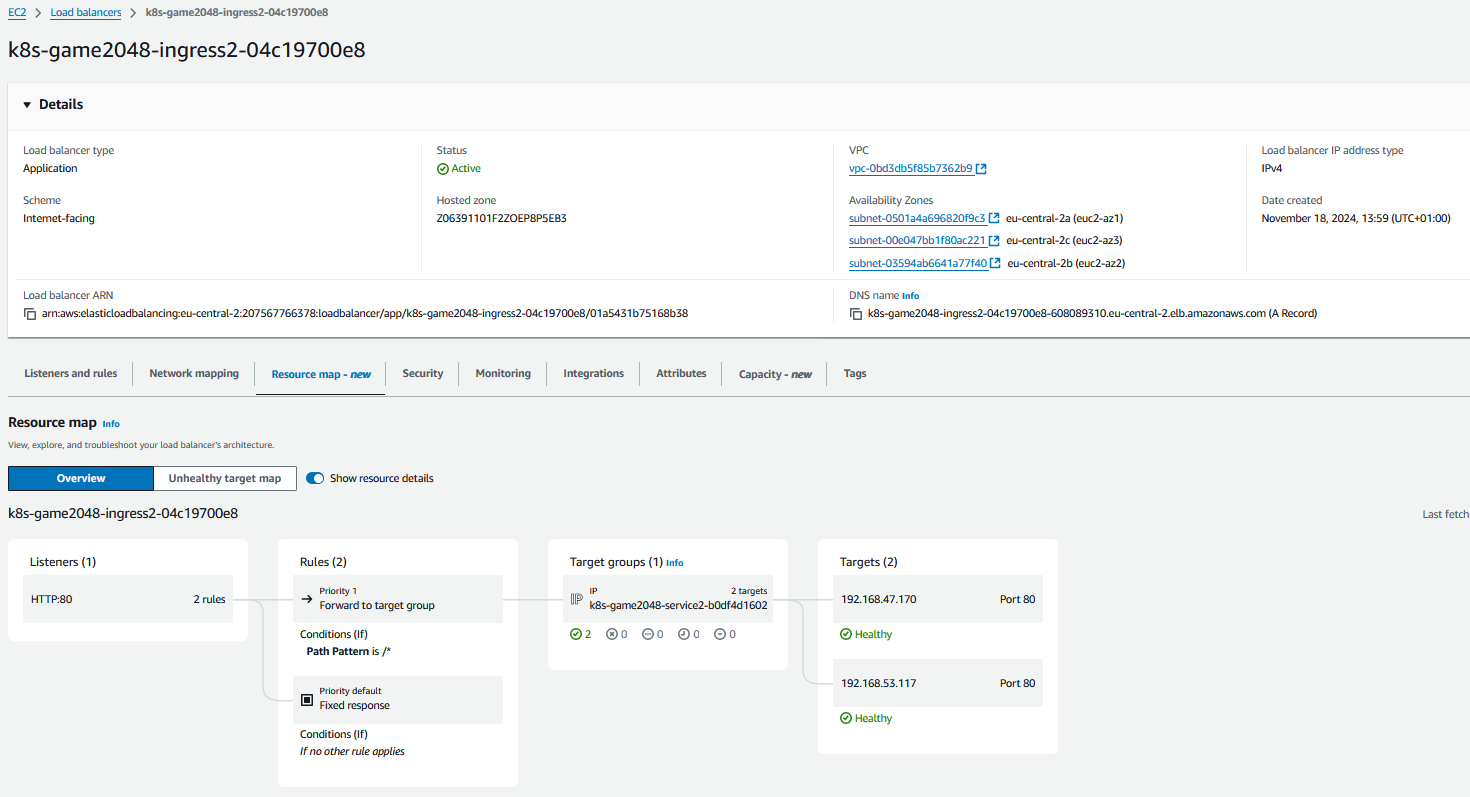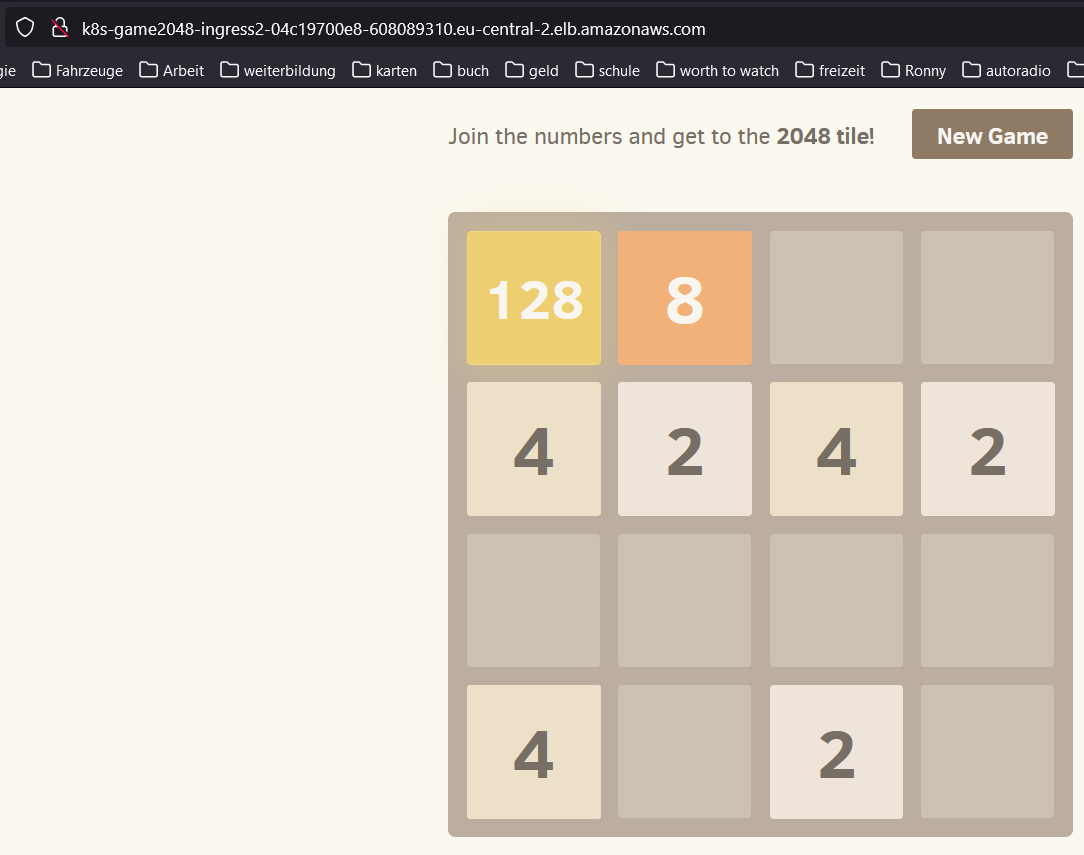3.4 AWS Loadbalancer mit Kubernetes Ingress
Von Seite AWS wird vorgeschlagen, ihren Loadbalancer als Ingress für Kubernetes zu verwenden. Wir greifen gerne auf diese Möglichkeit zurück. Dazu gibt es eine sehr detailierte Anleitung.
Diese ist unter diesem Link zu finden: https://docs.aws.amazon.com/eks/latest/userguide/aws-load-balancer-controller.html
Dazu muss zuerst einmal eine neue IAM Rolle erstellt werde. Dies aus dem Grund, dass der Kubernetes Cluster bei einem Ingress Deployment, selbstständig neue Ressourcen generieren muss. Damit man eine IAM Rolle für Service Accounts erstellen kann, muss man, laut AWS, eine OIDC hinzufügen.
OIDC
https://docs.aws.amazon.com/eks/latest/userguide/enable-iam-roles-for-service-accounts.html
mka@Tuxedo-Laptop:~$ cluster_name=eks-cluster
mka@Tuxedo-Laptop:~$ oidc_id=$(aws eks describe-cluster --name $cluster_name --query "cluster.identity.oidc.issuer" --output text | cut -d '/' -f 5)
mka@Tuxedo-Laptop:~$ echo $oidc_id
7D84FF8A8DE6F56A20A9B69EA38F3709
mka@Tuxedo-Laptop:~$ aws iam list-open-id-connect-providers | grep $oidc_id | cut -d "/" -f4
mka@Tuxedo-Laptop:~$ eksctl utils associate-iam-oidc-provider --cluster $cluster_name --approve
2024-11-15 19:42:46 [ℹ] will create IAM Open ID Connect provider for cluster "eks-cluster" in "eu-central-2"
2024-11-15 19:42:46 [✔] created IAM Open ID Connect provider for cluster "eks-cluster" in "eu-central-2"
mka@Tuxedo-Laptop:~$ aws iam list-open-id-connect-providers | grep $oidc_id | cut -d "/" -f4
7D84FF8A8DE6F56A20A9B69EA38F3709"
mka@Tuxedo-Laptop:~$
IAM User erstellen
AWS bietet auch hier eine Vorlage, welche man 1 zu 1 kopieren kann. Sie erlaubt dem Cluster alle Ressourcen zu erstellen welche er braucht. Mehr Informationen findet man im Code Fenster.
mka@Tuxedo-Laptop:~$ curl -O https://raw.githubusercontent.com/kubernetes-sigs/aws-load-balancer-controller/v2.7.2/docs/install/iam_policy.json
% Total % Received % Xferd Average Speed Time Time Time Current
Dload Upload Total Spent Left Speed
100 8446 100 8446 0 0 22907 0 --:--:-- --:--:-- --:--:-- 22951
mka@Tuxedo-Laptop:~$ aws iam create-policy --policy-name AWSLoadBalancerControllerIAMPolicy --policy-document file://iam_policy.json
{
"Policy": {
"PolicyName": "AWSLoadBalancerControllerIAMPolicy",
"PolicyId": "ANPATAVAAYNVJJN5AI4WP",
"Arn": "arn:aws:iam::**********:policy/AWSLoadBalancerControllerIAMPolicy",
"Path": "/",
"DefaultVersionId": "v1",
"AttachmentCount": 0,
"PermissionsBoundaryUsageCount": 0,
"IsAttachable": true,
"CreateDate": "2024-11-15T18:44:55+00:00",
"UpdateDate": "2024-11-15T18:44:55+00:00"
}
}
mka@Tuxedo-Laptop:~$ cat iam_policy.json
{
"Version": "2012-10-17",
"Statement": [
{
"Effect": "Allow",
"Action": [
"iam:CreateServiceLinkedRole"
],
"Resource": "*",
"Condition": {
"StringEquals": {
"iam:AWSServiceName": "elasticloadbalancing.amazonaws.com"
}
}
},
{
"Effect": "Allow",
"Action": [
"ec2:DescribeAccountAttributes",
"ec2:DescribeAddresses",
"ec2:DescribeAvailabilityZones",
"ec2:DescribeInternetGateways",
"ec2:DescribeVpcs",
"ec2:DescribeVpcPeeringConnections",
"ec2:DescribeSubnets",
"ec2:DescribeSecurityGroups",
"ec2:DescribeInstances",
"ec2:DescribeNetworkInterfaces",
"ec2:DescribeTags",
"ec2:GetCoipPoolUsage",
"ec2:DescribeCoipPools",
"elasticloadbalancing:DescribeLoadBalancers",
"elasticloadbalancing:DescribeLoadBalancerAttributes",
"elasticloadbalancing:DescribeListeners",
"elasticloadbalancing:DescribeListenerCertificates",
"elasticloadbalancing:DescribeSSLPolicies",
"elasticloadbalancing:DescribeRules",
"elasticloadbalancing:DescribeTargetGroups",
"elasticloadbalancing:DescribeTargetGroupAttributes",
"elasticloadbalancing:DescribeTargetHealth",
"elasticloadbalancing:DescribeTags",
"elasticloadbalancing:DescribeTrustStores"
],
"Resource": "*"
},
{
"Effect": "Allow",
"Action": [
"cognito-idp:DescribeUserPoolClient",
"acm:ListCertificates",
"acm:DescribeCertificate",
"iam:ListServerCertificates",
"iam:GetServerCertificate",
"waf-regional:GetWebACL",
"waf-regional:GetWebACLForResource",
"waf-regional:AssociateWebACL",
"waf-regional:DisassociateWebACL",
"wafv2:GetWebACL",
"wafv2:GetWebACLForResource",
"wafv2:AssociateWebACL",
"wafv2:DisassociateWebACL",
"shield:GetSubscriptionState",
"shield:DescribeProtection",
"shield:CreateProtection",
"shield:DeleteProtection"
],
"Resource": "*"
},
{
"Effect": "Allow",
"Action": [
"ec2:AuthorizeSecurityGroupIngress",
"ec2:RevokeSecurityGroupIngress"
],
"Resource": "*"
},
{
"Effect": "Allow",
"Action": [
"ec2:CreateSecurityGroup"
],
"Resource": "*"
},
{
"Effect": "Allow",
"Action": [
"ec2:CreateTags"
],
"Resource": "arn:aws:ec2:*:*:security-group/*",
"Condition": {
"StringEquals": {
"ec2:CreateAction": "CreateSecurityGroup"
},
"Null": {
"aws:RequestTag/elbv2.k8s.aws/cluster": "false"
}
}
},
{
"Effect": "Allow",
"Action": [
"ec2:CreateTags",
"ec2:DeleteTags"
],
"Resource": "arn:aws:ec2:*:*:security-group/*",
"Condition": {
"Null": {
"aws:RequestTag/elbv2.k8s.aws/cluster": "true",
"aws:ResourceTag/elbv2.k8s.aws/cluster": "false"
}
}
},
{
"Effect": "Allow",
"Action": [
"ec2:AuthorizeSecurityGroupIngress",
"ec2:RevokeSecurityGroupIngress",
"ec2:DeleteSecurityGroup"
],
"Resource": "*",
"Condition": {
"Null": {
"aws:ResourceTag/elbv2.k8s.aws/cluster": "false"
}
}
},
{
"Effect": "Allow",
"Action": [
"elasticloadbalancing:CreateLoadBalancer",
"elasticloadbalancing:CreateTargetGroup"
],
"Resource": "*",
"Condition": {
"Null": {
"aws:RequestTag/elbv2.k8s.aws/cluster": "false"
}
}
},
{
"Effect": "Allow",
"Action": [
"elasticloadbalancing:CreateListener",
"elasticloadbalancing:DeleteListener",
"elasticloadbalancing:CreateRule",
"elasticloadbalancing:DeleteRule"
],
"Resource": "*"
},
{
"Effect": "Allow",
"Action": [
"elasticloadbalancing:AddTags",
"elasticloadbalancing:RemoveTags"
],
"Resource": [
"arn:aws:elasticloadbalancing:*:*:targetgroup/*/*",
"arn:aws:elasticloadbalancing:*:*:loadbalancer/net/*/*",
"arn:aws:elasticloadbalancing:*:*:loadbalancer/app/*/*"
],
"Condition": {
"Null": {
"aws:RequestTag/elbv2.k8s.aws/cluster": "true",
"aws:ResourceTag/elbv2.k8s.aws/cluster": "false"
}
}
},
{
"Effect": "Allow",
"Action": [
"elasticloadbalancing:AddTags",
"elasticloadbalancing:RemoveTags"
],
"Resource": [
"arn:aws:elasticloadbalancing:*:*:listener/net/*/*/*",
"arn:aws:elasticloadbalancing:*:*:listener/app/*/*/*",
"arn:aws:elasticloadbalancing:*:*:listener-rule/net/*/*/*",
"arn:aws:elasticloadbalancing:*:*:listener-rule/app/*/*/*"
]
},
{
"Effect": "Allow",
"Action": [
"elasticloadbalancing:ModifyLoadBalancerAttributes",
"elasticloadbalancing:SetIpAddressType",
"elasticloadbalancing:SetSecurityGroups",
"elasticloadbalancing:SetSubnets",
"elasticloadbalancing:DeleteLoadBalancer",
"elasticloadbalancing:ModifyTargetGroup",
"elasticloadbalancing:ModifyTargetGroupAttributes",
"elasticloadbalancing:DeleteTargetGroup"
],
"Resource": "*",
"Condition": {
"Null": {
"aws:ResourceTag/elbv2.k8s.aws/cluster": "false"
}
}
},
{
"Effect": "Allow",
"Action": [
"elasticloadbalancing:AddTags"
],
"Resource": [
"arn:aws:elasticloadbalancing:*:*:targetgroup/*/*",
"arn:aws:elasticloadbalancing:*:*:loadbalancer/net/*/*",
"arn:aws:elasticloadbalancing:*:*:loadbalancer/app/*/*"
],
"Condition": {
"StringEquals": {
"elasticloadbalancing:CreateAction": [
"CreateTargetGroup",
"CreateLoadBalancer"
]
},
"Null": {
"aws:RequestTag/elbv2.k8s.aws/cluster": "false"
}
}
},
{
"Effect": "Allow",
"Action": [
"elasticloadbalancing:RegisterTargets",
"elasticloadbalancing:DeregisterTargets"
],
"Resource": "arn:aws:elasticloadbalancing:*:*:targetgroup/*/*"
},
{
"Effect": "Allow",
"Action": [
"elasticloadbalancing:SetWebAcl",
"elasticloadbalancing:ModifyListener",
"elasticloadbalancing:AddListenerCertificates",
"elasticloadbalancing:RemoveListenerCertificates",
"elasticloadbalancing:ModifyRule"
],
"Resource": "*"
}
]
}
mka@Tuxedo-Laptop:~$ eksctl create iamserviceaccount --cluster=eks-cluster --namespace=kube-system --name=aws-load-balancer-controller --role-name AmazonEKSLoadBalancerControllerRole --attach-policy-arn=arn:aws:iam::**********:policy/AWSLoadBalancerControllerIAMPolicy --approve
2024-11-15 19:48:34 [ℹ] 1 iamserviceaccount (kube-system/aws-load-balancer-controller) was included (based on the include/exclude rules)
2024-11-15 19:48:34 [!] serviceaccounts that exist in Kubernetes will be excluded, use --override-existing-serviceaccounts to override
2024-11-15 19:48:34 [ℹ] 1 task: {
2 sequential sub-tasks: {
create IAM role for serviceaccount "kube-system/aws-load-balancer-controller",
create serviceaccount "kube-system/aws-load-balancer-controller",
} }2024-11-15 19:48:34 [ℹ] building iamserviceaccount stack "eksctl-eks-cluster-addon-iamserviceaccount-kube-system-aws-load-balancer-controller"
2024-11-15 19:48:34 [ℹ] deploying stack "eksctl-eks-cluster-addon-iamserviceaccount-kube-system-aws-load-balancer-controller"
2024-11-15 19:48:34 [ℹ] waiting for CloudFormation stack "eksctl-eks-cluster-addon-iamserviceaccount-kube-system-aws-load-balancer-controller"
2024-11-15 19:49:04 [ℹ] waiting for CloudFormation stack "eksctl-eks-cluster-addon-iamserviceaccount-kube-system-aws-load-balancer-controller"
2024-11-15 19:49:04 [ℹ] created serviceaccount "kube-system/aws-load-balancer-controller"
Auf Seiten AWS ist nun also alles bereit, damit der Cluster die Ressourcen erstellen kann. Als nächstes müssen wir den Cluster dementsprechend konfigurieren.
HELM Install on Cluster
AWS bietet dazu ein HELM Chart an, was dies für uns erledigt.
mka@Tuxedo-Laptop:~$ helm repo add eks https://aws.github.io/eks-charts
WARNING: Kubernetes configuration file is group-readable. This is insecure. Location: /home/mka/.kube/config
WARNING: Kubernetes configuration file is world-readable. This is insecure. Location: /home/mka/.kube/config
"eks" has been added to your repositories
mka@Tuxedo-Laptop:~$ helm install aws-load-balancer-controller eks/aws-load-balancer-controller -n kube-system --set clusterName=eks-cluster --set serviceAccount.create=false --set serviceAccount.name=aws-load-balancer-controller
WARNING: Kubernetes configuration file is group-readable. This is insecure. Location: /home/mka/.kube/config
WARNING: Kubernetes configuration file is world-readable. This is insecure. Location: /home/mka/.kube/config
NAME: aws-load-balancer-controller
LAST DEPLOYED: Fri Nov 15 19:50:55 2024
NAMESPACE: kube-system
STATUS: deployed
REVISION: 1
TEST SUITE: None
NOTES:
AWS Load Balancer controller installed!
mka@Tuxedo-Laptop:~$ wget https://raw.githubusercontent.com/aws/eks-charts/master/stable/aws-load-balancer-controller/crds/crds.yaml
l apply -f crds.yaml--2024-11-15 19:51:46-- https://raw.githubusercontent.com/aws/eks-charts/master/stable/aws-load-balancer-controller/crds/crds.yaml
Resolving raw.githubusercontent.com (raw.githubusercontent.com)... 185.199.108.133, 185.199.111.133, 185.199.109.133, ...
Connecting to raw.githubusercontent.com (raw.githubusercontent.com)|185.199.108.133|:443... connected.
HTTP request sent, awaiting response... 200 OK
Length: 29410 (29K) [text/plain]
Saving to: ‘crds.yaml’
crds.yaml 100%[=====================================================================================================================>] 28.72K --.-KB/s in 0s
2024-11-15 19:51:46 (122 MB/s) - ‘crds.yaml’ saved [29410/29410]
mka@Tuxedo-Laptop:~$ kubectl apply -f crds.yaml
Warning: resource customresourcedefinitions/ingressclassparams.elbv2.k8s.aws is missing the kubectl.kubernetes.io/last-applied-configuration annotation which is required by kubectl apply. kubectl apply should only be used on resources created declaratively by either kubectl create --save-config or kubectl apply. The missing annotation will be patched automatically.
customresourcedefinition.apiextensions.k8s.io/ingressclassparams.elbv2.k8s.aws configured
Warning: resource customresourcedefinitions/targetgroupbindings.elbv2.k8s.aws is missing the kubectl.kubernetes.io/last-applied-configuration annotation which is required by kubectl apply. kubectl apply should only be used on resources created declaratively by either kubectl create --save-config or kubectl apply. The missing annotation will be patched automatically.
customresourcedefinition.apiextensions.k8s.io/targetgroupbindings.elbv2.k8s.aws configured
Test Applikation
Um zu testen ob dies auch wirklich funktioniert bietet sich eine kleine Testapplikation an.
mka@Tuxedo-Laptop:~$ kubectl apply -f https://raw.githubusercontent.com/kubernetes-sigs/aws-load-balancer-controller/v2.7.2/docs/examples/2048/2048_full.yaml
namespace/game-2048 created
deployment.apps/deployment-2048 created
service/service-2048 created
ingress.networking.k8s.io/ingress-2048 created
mka@Tuxedo-Laptop:~$ kubectl get ingress/ingress-2048 -n game-2048
NAME CLASS HOSTS ADDRESS PORTS AGE
ingress-2048 alb * k8s-game2048-ingress2-04c19700e8-1901553064.eu-central-2.elb.amazonaws.com 80 15s
Dies erstellt einen Loadbalancer, welcher den Traffic auf der URl weiterleitet an die Nodes.
http://k8s-game2048-ingress2-04c19700e8-608089310.eu-central-2.elb.amazonaws.com/
Wenn wir die URL des Loadbalancers in einem Browser aufrufen, ist der Service direkt verfügbar.
Das Deployment dieses Spiel ist dabei sehr einfach.
---
apiVersion: v1
kind: Namespace
metadata:
name: game-2048
---
apiVersion: apps/v1
kind: Deployment
metadata:
namespace: game-2048
name: deployment-2048
spec:
selector:
matchLabels:
app.kubernetes.io/name: app-2048
replicas: 2
template:
metadata:
labels:
app.kubernetes.io/name: app-2048
spec:
containers:
- image: public.ecr.aws/l6m2t8p7/docker-2048:latest
imagePullPolicy: Always
name: app-2048
ports:
- containerPort: 80
---
apiVersion: v1
kind: Service
metadata:
namespace: game-2048
name: service-2048
spec:
ports:
- port: 80
targetPort: 80
protocol: TCP
type: NodePort
selector:
app.kubernetes.io/name: app-2048
---
apiVersion: networking.k8s.io/v1
kind: Ingress
metadata:
namespace: game-2048
name: ingress-2048
annotations:
alb.ingress.kubernetes.io/scheme: internet-facing
alb.ingress.kubernetes.io/target-type: ip
spec:
ingressClassName: alb
rules:
- http:
paths:
- path: /
pathType: Prefix
backend:
service:
name: service-2048
port:
number: 80

